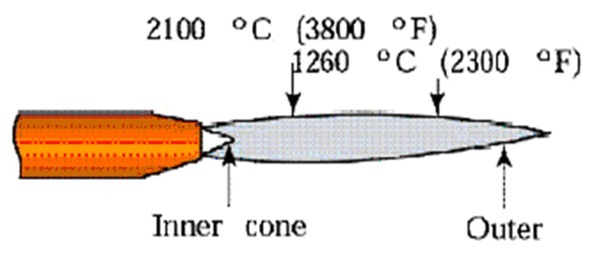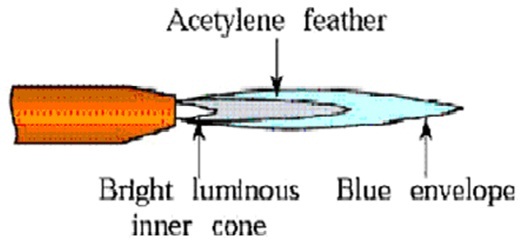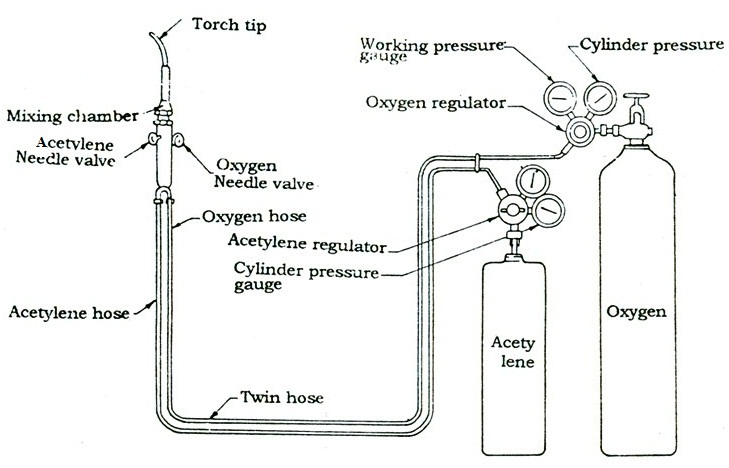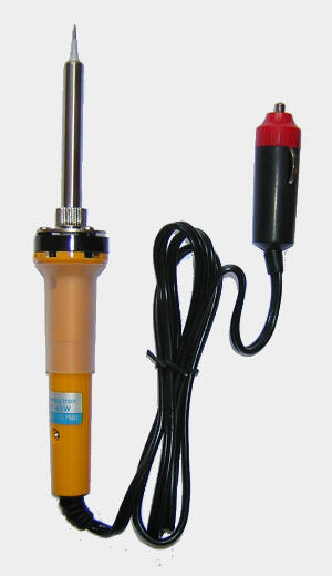Site pages
Current course
Participants
General
Topic 1
Topic 2
Topic 3
Topic 4
Topic 5
Topic 6
Topic 7
Topic 8
Topic 9
Lesson 9. GAS WELDING
Module 5. Welding
Lesson 9
GAS WELDING
9.1 Introduction
In gas welding the heat required for heating and melting the parent and filler metals is obtained by the combustion of a fuel gas with oxygen. Fuel gases used in commercial gas welding practice are acetylene, hydrogen and natural gas.
Acetylene is the most widely used because the temperatures obtained by combustion of acetylene are much higher than those obtained by combustion of hydrogen or natural gas. Oxy-hydrogen flame may be used for welding thin sheets of steel and low temperature melting materials and alloys.
9.2 Supply of Oxygen and Acetylene
Oxygen is industrially produced by electrolysis of water or by liquidation of air and separating oxygen. The gas produced is compressed and charged into cylinder with 40 liter capacity to a pressure of about 15.4MPa at 21ºC temperature.
Commercial acetylene is produced by the action of water on calcium carbide. High pressure storing and distribution of acetylene in cylinder is done by dissolving the gas in acetone. The steel cylinder used for storing acetylene is first packed with 80% porous material such as asbestos, or charcoal. Acetylene cylinders contain 1.7 to 9 cubic metres of free acetylene at a pressure of 1.7 MPa and a temperature of 20oC.
9.3 Oxyacetylene Flame
The oxyacetylene flame, like all other flames, is produced when the two gases meet and undergo combustion with the evolution of heat and light. With commercially pure oxygen and acetylene the hottest known flame is produced with an estimated temperature around 3500 oC.
The flame temperature obtained depends on the relative proportion of the fuel gas and oxygen drawn in the pure form. Since temperature is not the only requirement in commercial application of the oxyacetylene flame varying ratios of oxygen and acetylene have been found suitable for different applications.
Types of flames:
Flames can be classified into three categories:
1. Balanced or neutral flame.
2. Reducing or carburizing flame.
3. Oxidising flame.
Balanced or neutral flame: The balanced or neutral flame is produced by burning a one-to-one mixture of oxygen and acetylene at the tip of the torch nozzle. This flame is characterized by a well defined luminous cone gradually rounding off towards the tip.

Fig. 9.1 Neutral flame
The intermediate zone is slightly reducing in nature and cannot be distinguished from the inner cone and the outside envelope. Welding is done using the flame in this zone. The envelope is neutral in nature and provides a protective atmosphere around the weld. The neutral flame is the most generally used flame for all heating and welding applications.

Fig. 9.2 Reducing or carburising flame
The intermediate zone contains some free oxygen from the torch. It may also contain some carbon dioxide and is oxidizing in nature. This flame being the hottest of the oxyacetylene flames is used where the maximum flame temperature is desired. The oxidizing flame is used as a preheating flame in many oxyacetylene cutting operations. It is also used in the fusion welding of nonferrous metals, particularly, brass and bronze. The intense heat of the flame also takes care of the greater loss of heat associated with high thermal conductivity of non ferrous metals.

Fig. 9.3 Reducing or carburising flame
The intermediate zone contains free carbon along with carbon monoxide and hydrogen.
It is reducing as well as carburizing in nature. If too much of acetylene in proportion to oxygen is supplied by the torch the envelope may also carry some carbon. The reducing flame finds applications where the highly reducing nature of the flame is conductive to welding as well as in cases where the carburizing nature offers an advantage.
It is used in the welding of metals like nickel, alloy steels and many of the non-ferrous hard surface materials. The carburizing nature of the flame is taken advantage of in the welding of low carbon steels to increase the rate of welding.
9.4 Flame Temperature
Temperature is one of the important characteristics of the flame. Higher the temperature more efficient is the heating and melting of the metal. The temperature of the flame is not constant. It varies along and across the flame and depends on the composition of the flame.
Welding is done using the flame in this zone. It decides the nature of the flame-reducing, carburizing or oxidizing. The flame temperature depends on the oxygen to acetylene ratio and increases with increase in this ratio upto a certain point. The limiting values are 1.2 to 1.9 with corresponding temperatures of 3300 to 35000C. The maximum temperature obtained in a reducing flame is about 29000C, that in a neutral flame about 32500C and for an oxidizing flame about 35000C.
9.5 Oxy-Acetylene Welding Equipment
Majority of the oxy-acetylene welding is done manually. The commonly used oxy-acetylene welding set up consists of a welding torch with a set of tips, hoses, pressure regulators, cylinders containing oxygen and acetylene under pressure and accessories such as goggles, friction lighter and gloves. The basic set up is mounted on a trolley making it portable so that it can be readily taken to the job site.

Fig. 9.4 Oxy-acetylene welding set
9.6 Welding Torch
The oxyacetylene welding torch is a device used for mixing the two gases in proportions, burning the mixture at the end of the tip and moving and directing the flame. The torch has a handle at one end of which are the inlet connections for the gases and valves for controlling the quantity of the gases. At the other end of the handle are the mixing chamber followed by the tip. The oxyacetylene flame is produced by lighting the mixture at torch tip.
Welding torch tips are made of a nonferrous metal such as copper because of its high thermal conductivity. High thermal conductivity of the tip material permits the tips to run cool and reduces the danger of their burning at high temperatures. Larger tip sizes, which release more gas mixture and produce more heat are used for welding thicker pieces of metal.
9.7 Pressure Regulators
The functions of pressure regulators are to reduce the high cylinder pressure to the desired working pressure, and to maintain a constant working pressure and volumetric rate of gas flow regardless of the gas source pressure variations.
Two pressure gauges are provided on the regulator, one to read the cylinder pressure and the other to read the pressure at which the gas is delivered to the torch. The desired working pressure is adjusted by a hand screw. When this screw is turned counter clock-wise till it runs free the valve in the regulator is closed and no gas can pass through. When the hand screw is turned clockwise the valve in the regulator opens and the gas passes through to the torch. The desired pressure is set by turning the screw handle till the pressure gauge reads this pressure.
9.8 Hoses
Hoses used for gas welding torches should be strong, non-porous, flexible and light. Reinforced rubber hoses specially made for the purpose are employed. Care should be taken to see that the hoses are not interchanged.
Colour code and safety.
Green or black colour is used for oxygen cylinders, hose and knobs on torches and maroon or red for acetylene cylinder, hoses, and knobs. All oxygen connections have right hand threads and acetylene connections left hand threads. This is done for proper identification and to avoid possible mistake in connections which may lead to dangerous consequences.
9.9 Welding rods
The properties and composition of a weld should match those of the base metal closely. For this reason different types of welding rods have been developed for welding of various ferrous and non ferrous metals.
The molten filler metal must flow smoothly and freely and unite with the base metal to produce sound, clean welds. Welding rods for ferrous metals are designed for producing welds of high tensile strength and ductility. Some of the rods are alloyed with silicon, manganese, nickel, chromium, vanadium, molybdenum and other metals to suit different welding requirements. Stainless steel is welded with rods containing chromium, nickel and titanium, molybdenum or niobium.
Welding rods are produced in a variety of diameter sizes ranging from 1.5.mm to 10 mm and in standard length of about 1 meter.
9.10 Oxyacetylene Welding Techniques
In oxyacetylene welding, the weld is started by preheating the base metal and producing a small puddle of molten metal.
In forehand welding the rod leads the torch in the direction of welding and the flame is directed forward in the direction in which weld is progressing. This technique produces good looking neat welds and is used for welding thin metal sheets up to 4 mm thick. Forehand welding as defined for a right hander with torch in right hand and filler rod in the left hand is leftwards and is also called leftward or forward welding.
In the backhand welding the torch leads the rod in the direction of travel and the flame is directed back at the molten metal puddle and the completed weld. This is a great help while welding in position like vertical or overhead where the molten metal otherwise may easily flow out of the weld. More heat is concentrated at the weld zone making the process suitable for welding of thicker work pieces. For a right hander backhand welding proceeds rightwards and hence is also called rightward or backward welding. Backward welding is used in pipe and plate welding.
Related Process
9.11 Oxygen Cutting
Oxygen cutting is a process of controlled oxidation of ferrous metal. It is used extensively for cutting large metal pieces in the fabrication industry. For plain carbon steels the kindling or ignition temperature ranges from 750 to 8500C. This corresponds to a bright red colour in day light. If a starting spot, normally at the edge of the piece, is heated to the kindling temperature and a jet of commercially pure oxygen is directed at the spot a very active chemical reaction results leading to oxidization or burning of steel. The iron oxide formed is very brittle and a narrow slot with uniformly smooth parallel walls is formed along the path of the jet. With skilled workmanship and mechanically guided cutting torches deep cuts with close tolerances and alignment can be made.
9.12 Gas Cutting Equipment
Gas cutting equipment is similar to the gas welding equipment except for the torch and the specially designed cutting oxygen regulator. The cutting torch heats the steel to kindling temperature with a number of small preheating oxyacetylene flames. These surround the central hole for the stream of oxygen which will do the cutting. Cutting oxygen pressure regulators are specially designed to deliver oxygen in large volumes and at higher pressure. They are fitted with working pressure gauges with a range up to 300 KPa. Cutting torches may be operated by hand or by machine. Machine operated oxygen cutting torches are manipulated mechanically, but the basic elements remain unchanged.
9.13 Soldering
Soldering is a process in which two or more metal items are joined together by melting and flowing a filler metal into the joint, the filler metal having a relatively low melting point than the melting point of metals to be joined.
a) Soft soldering is characterized by the melting point of the filler metal, which is below 400 °C. The filler metal used in the process is called solder , is an alloy of tin and lead. It is used extensively in sheet metal work for joining parts that not exposed to the action of high temperatures and are not subjected to excessive loads and forces. A suitable flux to prevent oxidation of the surfaces to be soldered is used. Zinc chloride is the most common soldering flux.
b) Hard soldering employs solders which melts at high temperatures and are stringer than the soft soldering. The temperature of various hard solders vary f rom 600 to 900°C. When silver alloyed with tin is used as solder to join the parts, it is known hard soldering.
A soldering iron is a device for applying heat to melt solder for attaching two metal parts. A soldering iron is composed of a heated metal tip and an insulated handle. Heating is often achieved electrically, by passing a current, supplied through an electrical cord or a battery, through a heating element. Another heating method includes combustion of a suitable gas, which can either be delivered through a tank mounted on the iron (flameless), or through an external flame.

Fig. 9.5 Soldering
• Low process temperature;
• No thermal distortions and residual stresses in the joint parts;
• Microstructure is not affected by heat;
• Easily automated process;
• Dissimilar materials may be joined;
• High variety of materials may be joined;
• Thin wall parts may be joined;
• Moderate skill of the operator is required.
c) Brazing